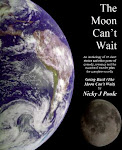Non-fiction popular science article about how literally pin-pricks of evidence have led us to learn about the entire Universe.
Every single night, over your head, over my head, over every single person’s head in the entire world, something utterly remarkable takes place. It will happen tonight, tomorrow night and every night for as far as we can imagine into the future, as it has done for as far as we can imagine into the past. Every night, it goes dark.
Now at first you may not think that this very much to get excited about. After all, nightfall is about as predictable as anything can get – as predictable as the dawn that will follow. And yet, it is in the minutiae of things, the details, the tiny, that, at first glance, seem so trivial, that so often lie the greatest wonder, the most amazing discovery and the most challenging concepts to face the human mind. In this particular instance, all I should need to do is ask you a simple question for you to see why. That question is, "Why does it go dark?" In attempting to answer that question, we are taken, in almost a single bound, from the mundane, the trivial, to the heart of some of the greatest of mysteries.
Let us add to this mystery, before even attempting to answer our simple question. If you are lucky – and it happens to everybody sooner or later – I ask you to trust me on this – the weather at night will be fine, and the sky, we say, is clear. But it is when the sky is what we call "clear" that it is anything but! The merest glance at a cloudless night sky reveals even to someone with eyesight as limited as mine, thousands of tiny pin-pricks of light. Tiny, twinkling and terrifically important. For they are the stars, the populace of the vast "everything-ness" we call The Universe. It’s the greatest show on Earth.
It is because of the fact that we live on a planet that is round, held to its surface by a force called gravity and that once in every twenty-four hours this planet turns its back on the closest star, the Sun, that it goes dark at night. But there is still more to this mystery. A lot more. For example, if the Universe is infinite, there should be a star in every direction that we look. But there is not. The gaps between the stars are dark. This leads, though a chain of reasoning, to the astonishing, astounding conclusion that the Universe had a beginning. It has had an evolution. We have yet to determine whether it will have an end. And as for what might come after that, well, your guess is quite literally as good as mine or anybody else’s.
For thousands of years – more probably, tens of thousands, our ancestors looked up at the night sky, and wondered – surely one of the most striking of human characteristics. That wonder hungered for explanation. What were the stars? How did they work? What held them together? Various mythologies were created to feed this hunger. Gods and familiars, creatures and creations, the scintillating ciphers that would seal our fates. Poetic, strange, beautiful and believable, but, sadly, fictional artefacts of man’s mind – not a verifiable explanation. For a hundred thousand generations perhaps, this was all we could tell of the stars. Now, suddenly, within a single generation, we have worked out most of it.
Most stars are vast aggregations of hydrogen gas – the stuff you put in party balloons to make them roll around the ceiling, instead of rolling around the floor. The tiny points are in fact staggeringly huge balls of fire – the average star would encircle both the Earth and the Moon that orbits it. Indeed, three quarters of The Universe is just hydrogen, most of the rest is called helium, which we will meet again in a moment, and everything else makes up just 2%. But it’s that 2% that makes us, amongst other things, and in turn makes the 2% so interesting. Again, it’s the little things that count.
The hydrogen gas is brought and held together by gravity – not the mightiest force in The Universe, but its feeblest – having one distinction from other forces such as magnetism – it is always only one way. To gravity, everything is down. It makes no exceptions. Unopposed, gravity’s effect accumulates from seemingly trivial to tremendous, until it has dominion over all. Gravity takes the lightest of gases, and crushes it till it glows with incandescence. And it doesn’t stop there. Once greedy gravity has squeezed every iota of energy from its prisoner, the very heart of the particles begin to fuse together to produce newer, heavier elements. It is only fitting that the first of these was found in, and named after, the Sun, the element helium, from the Greek word for the Sun, Helios.
Gravity knows no mercy. It continues to crush the elements together, releasing yet more energy. In doing so, each one gives out a characteristic signature of light. Those tiny pin-pricks in the sky - still pin-points even through the most powerful telescope, can have their light dissected, like a specimen on a slide, to reveal that signature and thus give away the star’s components, its age, its true brightness, hence its distance and a fair few other facts besides. Not bad for a pin-prick. Forensic science, hunting for the fingerprints of creation.
And so many of the chemical elements with which we are familiar on Earth were and are created – carbon – essential for all living chemistry, oxygen, phosphorus – a key part of deoxyribonucleic acid, or DNA. Not to mention water – the key to life, and alcohol, the key to a good night out. If you want to wake up with stars in your head, that is!
But then comes a twist in the story. Once a star is so crushed that it starts to create the humble element, iron, one of the first and most useful metals humans ever extracted from rocks, the process hits a brick wall and halts. Creating still heavier elements uses energy rather than releasing it. The alchemist’s dream, of turning base metal into gold, remains, for the moment, beyond reach. But not for long. Gravity knows no mercy. If a star can’t burn, it is crushed still further, like the stubbing out of a cigarette. The star abruptly collapses in on itself. Like anything crashing to the ground, this releases more energy – enough to convert iron to lead, lead into silver, platinum and gold, and gold into uranium and beyond. Then the star explodes, like a cross between a smelting factory and a junk yard, scattering its trash and treasures through the heavens.
Then, gravity, tireless gravity, slowly, irredeemably, irresistibly, begins to haul the stuff back together again. This insistence of harvesting matter creates new stars, and metallic-cored planets such as the Earth are formed. Planets with carbon dioxide and water, ammonia and methane, phosphates and sugars, the ingredients for life. And what does life lead to? Wonder.
The study of the stars – astronomy, as it is known – is, in a way, the study of everything. It is wonder put into practice. Where we came from, where we are going and above all where we are. We live in a Universe that may have had a divine creator, or it may be that it is the way it is because it could not be any other way. What you believe about who you are and why is really up to you. But the "how" and the "what" that makes us, our planet and our star, along with all the other stars, comes from our looking at the skies and making the logical deductions from our observations, from a forensic examination of the dark sky that makes CSI Miami look like bumbling guesswork!
This is wonder at work. And it all starts with looking at those little spots of light on a clear night.
It’s something to think about when it goes dark this evening. It’s the greatest show on Earth.
The End
.jpg)






No comments:
Post a Comment